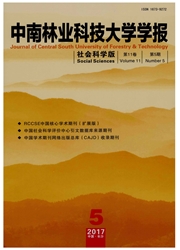

 中文摘要:
中文摘要:
假设旅游地各类利益相关者的内禀增长率α受到游客教育活动的随机干扰,参照Logistic模型,构建了游客教育活动持续作用下多利益相关者的增长模型,获得了在游客教育这种外力干预影响下,旅游地人类生态系统存在性以及可持续发展的条件。其主要步骤和方法是:先把游客教育归化为一个数学上反映其基本现象的微分动力模型,然后用数学的解析方法得到足够精度的近似解,再以求得的结果为依据,从生态学、社会学、教育学、数学、物理学等多角度来分析其动态规律。分析发现,旅游地利益相关者内禀增长率随机化后,随机项能压制解的增长,且内禀增长率的确定项系数和随机项系数满足一定条件后,旅游地人类生态系统会得以安全发展,所以运用游客教育干预手段来调节旅游地利益相关者内禀增长率,从而促进旅游地社会生态系统和自然生态系统的和谐稳定是可行的。
 英文摘要:
英文摘要:
Abstract: The increase model of multi-stakeholders that the tourist education activity acts uninterruptedly on, were set up by consulting Logistic model, base of the hypothesis that the intrinsic rate of increase (a) of multi-stakeholders in the sightseeing district affected the random disturbance of the tourist education activity. The existence of the sightseeing district and conditions for sustainable development were studied with the outside interference of tourist education. The modeling method and procedures were as followings: firstly, the tourist education activity was naturalized as a differential dynamic model which can reflect the basic phenomena of the sightseeing district; then through mathematical analysis method, the approximate solutions with sufficient accuracy were obtained; finally according to the solutions, from the multi-angles of ecology, sociology, pedagogics, mathematics, physics etc., the dynamic laws of tourist education Groups of the sightseeing district were analyzed. The analysis results show that after the intrinsic rate of increase (a) of multi- stakeholders in the sightseeing district was randomized, the random entry could suppressed the increase of the solutions, and after the intrinsic increase rate's uncertain term coefficients and random term coefficients had been satisfied the controlled conditions, the human ecology system in the tourism destination could safely develop. So, it is feasible that using tourist education interventions regulate the intrinsic rate of increase (a) of multi-stakeholders in the sightseeing district, and further promote social harmonious stability in ecological systems and natural ecosystems in the sightseeing district. Key words: tourist education; educational intervention; stochastic component; intrinsic rate of increase; ecological tourism system; Biological dynamic model of human groups
 同期刊论文项目
同期刊论文项目
 同项目期刊论文
同项目期刊论文
 Robustness analysis of global exponential stability of neural networks with Markovian switching in t
Robustness analysis of global exponential stability of neural networks with Markovian switching in t 期刊信息
期刊信息
